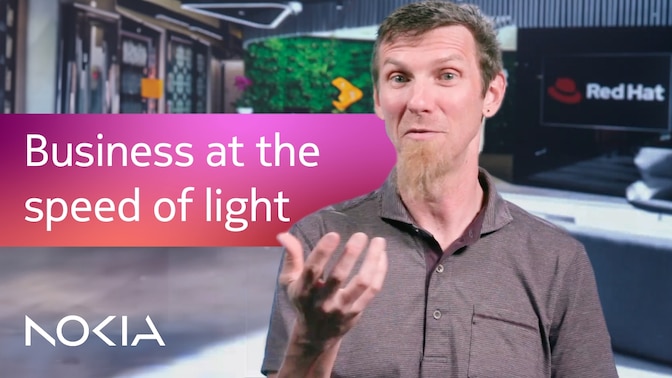Business at the
speed of light
Chris Wright, Chief Technology Officer of Red Hat and Director at the IOWN Global Forum, discusses the difference photonic networks will make to business and society.
Business at the speed of light
Data volumes keep on exploding and networks must evolve to handle the deluge. In the latest episode of the Network Effect, Chris Wright, Chief Technology Officer of Red Hat and Director at the IOWN Global Forum, discusses the difference photonic networks will make to business and society.
Artificial Intelligence demand is changing the future of communications networks. As AI drives an unprecedented explosion in data generation and transmission, the world’s networks must evolve to handle this deluge. Nowhere is this more evident than in the Vision 2030 roadmap laid out by the Innovative Optical Wireless Network (IOWN) Global Forum. By 2030, it’s estimated that network traffic will be nine times greater than in 2020, with the internet transmitting up to 58 zettabytes worth of data annually.
At the forefront of this transformation is Chris Wright, Chief Technology Officer of Red Hat and a leading figure in the IOWN Global Forum. Wright's insights shed light on the challenges and opportunities presented by this data-driven future. "As we generate all of this data, how can we process it, harness it, make use of it? Bringing data and compute closer together is the critical way to solve this future world, which definitely includes AI," says Wright.
The IOWN Global Forum’s Vision 2030 is built around the promise of photonic networks—a leap beyond traditional electronic networks. The primary focus is on speed, efficiency, and capacity, all enabled by photonics. Wright explains, "The biggest gap is in the actual network connectivity fabric itself. The way networks are built today are through traditional electronics. In IOWN, we're looking at photonics, which brings a lower power, higher bandwidth, lower latency connectivity fabric. And that's what brings those sensors and that data closer to the compute that kind of builds this next generation infrastructure."
In addition to redefining network infrastructure, the IOWN Global Forum is also helping lay the groundwork for 6G. As Wright highlights, the future of wireless communication isn't just about faster speeds but about a fundamental shift in the network's backbone. "Wireless network includes connected portions of the network. While we're not necessarily changing the wireless part of the network, we're changing the entire infrastructure that's behind that." This approach will enable 6G to support the exponential growth of IoT devices and integrate digital twins, blending the virtual and physical worlds in ways previously unimaginable.
The implications of this shift are vast. The Forum is not just about developing faster networks; it's about creating the infrastructure that will support the innovations of tomorrow—remote medicine, smart cities, and perhaps even flying cars. These advancements are all contingent on the ability to handle immense amounts of data quickly and efficiently. Wright emphasizes the importance of collaboration in achieving these ambitious goals: "There's an amplification or a multiplication of impact that happens when you connect people. So to me that network effect is about, you know, passing on your ideas and helping others get infectiously enthused about the same idea that you're excited about."
This network effect is more than just a technological marvel; it’s a social and economic necessity. The IOWN Global Forum brings together 140 organizations from around the world, including Microsoft, Nokia and Red Hat, with each contributing to the shared vision of a more connected and efficient future. As Wright points out, the collaborative nature of the Forum is crucial: "Having that shared vision, which here is improving networks at a technology level, but really looking at the entire impact of that technology improvement to the earth, to the humans that populate the earth. So that's our driving focus."
As we look ahead to 2030, the work of Wright and his colleagues at the IOWN Global Forum is set to redefine how we connect, communicate, and live. By drastically reducing latency, increasing transmission capacity, and slashing power consumption, the networks of the future will not only support the technological advancements of the next decade but will also help bridge the digital divide and improve the quality of life across the globe. In this interconnected world, the network effect will be the catalyst for change, driving innovation and making Vision 2030 a reality.




